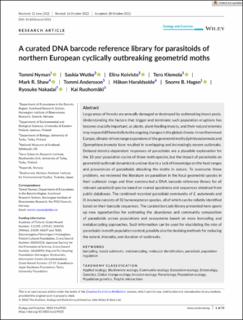| dc.contributor.author | Nyman, Tommi | |
| dc.contributor.author | Wutke, Saskia | |
| dc.contributor.author | Koivisto, Elina | |
| dc.contributor.author | Klemola, Tero | |
| dc.contributor.author | Shaw, Mark R. | |
| dc.contributor.author | Andersson, Tommi | |
| dc.contributor.author | Haraldseide, Håkon | |
| dc.contributor.author | Hagen, Snorre | |
| dc.contributor.author | Nakadai, Ryosuke | |
| dc.contributor.author | Ruohomäki, Kai | |
| dc.date.accessioned | 2023-04-04T10:02:53Z | |
| dc.date.available | 2023-04-04T10:02:53Z | |
| dc.date.created | 2022-12-14T13:42:10Z | |
| dc.date.issued | 2022-11-18 | |
| dc.identifier.citation | Ecology and Evolution. 2022, 12 (11), . | en_US |
| dc.identifier.issn | 2045-7758 | |
| dc.identifier.uri | https://hdl.handle.net/11250/3062033 | |
| dc.description.abstract | Large areas of forests are annually damaged or destroyed by outbreaking insect pests. Understanding the factors that trigger and terminate such population eruptions has become crucially important, as plants, plant-feeding insects, and their natural enemies may respond differentially to the ongoing changes in the global climate. In northernmost Europe, climate-driven range expansions of the geometrid moths Epirrita autumnata and Operophtera brumata have resulted in overlapping and increasingly severe outbreaks. Delayed density-dependent responses of parasitoids are a plausible explanation for the 10-year population cycles of these moth species, but the impact of parasitoids on geometrid outbreak dynamics is unclear due to a lack of knowledge on the host ranges and prevalences of parasitoids attacking the moths in nature. To overcome these problems, we reviewed the literature on parasitism in the focal geometrid species in their outbreak range and then constructed a DNA barcode reference library for all relevant parasitoid species based on reared specimens and sequences obtained from public databases. The combined recorded parasitoid community of E. autumnata and O. brumata consists of 32 hymenopteran species, all of which can be reliably identified based on their barcode sequences. The curated barcode library presented here opens up new opportunities for estimating the abundance and community composition of parasitoids across populations and ecosystems based on mass barcoding and metabarcoding approaches. Such information can be used for elucidating the role of parasitoids in moth population control, possibly also for devising methods for reducing the extent, intensity, and duration of outbreaks. | en_US |
| dc.language.iso | eng | en_US |
| dc.publisher | John Wiley & Sons Ltd. | en_US |
| dc.rights | Navngivelse 4.0 Internasjonal | * |
| dc.rights.uri | http://creativecommons.org/licenses/by/4.0/deed.no | * |
| dc.title | A curated DNA barcode reference library for parasitoids of northern European cyclically outbreaking geometrid moths | en_US |
| dc.title.alternative | A curated DNA barcode reference library for parasitoids of northern European cyclically outbreaking geometrid moths | en_US |
| dc.type | Peer reviewed | en_US |
| dc.type | Journal article | en_US |
| dc.description.version | publishedVersion | en_US |
| dc.rights.holder | © 2022 The Authors | en_US |
| dc.source.pagenumber | 15 | en_US |
| dc.source.volume | 12 | en_US |
| dc.source.journal | Ecology and Evolution | en_US |
| dc.source.issue | 11 | en_US |
| dc.identifier.doi | 10.1002/ece3.9525 | |
| dc.identifier.cristin | 2093159 | |
| dc.relation.project | Norges forskningsråd: 226134 | en_US |
| dc.source.articlenumber | e9525 | en_US |
| cristin.ispublished | true | |
| cristin.fulltext | original | |
| cristin.qualitycode | 1 | |

